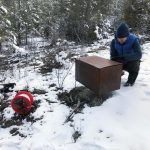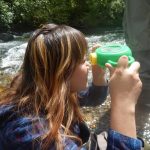DFO funds Aquatic Species at Risk Project in the Columbia Basin

Columbia Basin, March 22, 2020 – Aquatic species and their habitats are at risk in the Columbia Basin and a new Living Lakes Canada project is helping to protect them.
Living Lakes Canada recently received a $1.09 million grant from the Fisheries and Oceans Canada Canada Nature Fund for Aquatic Species at Risk program to complete a “Foreshore Inventory and Mapping (FIM) for Aquatic Species at Risk Project” in the Columbia Basin.
The four-year project was launched in late 2019. The first phase of the project included a series of workshops with participation from First Nations; municipal, regional, provincial and federal governments; environmental consultants; and NGO representatives (see photo below). The workshops were aimed at reviewing and revising the existing FIM methodology in order to improve its application for Columbia Basin lakes.
Since 2006, FIM has been completed on 13 lakes across the Columbia Basin, including:
-
-
- Lake Windermere
- Columbia Lake
- Wasa Lake
- Moyie Lake
- Monroe Lake
- Jimsmith Lake
- Tie Lake
- Rosen Lake
- St Mary Lake
- Koocanusa Reservoir
- Kootenay Lake
- Slocan Lake
- Brilliant Headpond
-
The Living Lakes Canada project will map or re-map six to eight priority lakes in the Columbia Basin over four years. The first two lakes will be selected and announced this spring.
“The project is very timely given that some lake reports are now more than 10 years old. We are excited to be working with DFO and our other partners to strengthen shoreline habitat conservation across the Columbia Basin,” said Living Lakes Canada Project Manager Heather Leschied.
FIM takes an inventory and maps shoreline habitats for fish and wildlife, assesses habitat value, and establishes Foreshore Management Guidelines. The aim of these guidelines is to conserve sensitive habitats, improve ecosystem resiliency in the face of climate change, and protect species of conservation concern. They also provide a benchmark by which to compare habitat changes over time.
The project will benefit a number of Species at Risk in the Columbia Basin, including the Westslope Cutthroat Trout (Oncorhynchus clarkii lewisi), White Sturgeon (Acipenser transmontanus), Shorthead Sculpin (Cottus confusus) and Columbia Sculpin (Cottus hubbsi), and the Umatilla Dace (Rhinichthys umatilla) among others.
The Canada Nature Fund for Aquatic Species at Risk (CNFASAR) is delivered by Fisheries and Oceans Canada and is part of Canada’s Nature Initiative, which was launched in May 2018. The CNFASAR will provide $55 million over 5 years to support projects that help to recover aquatic species at risk. The objective of the CNFASAR is to slow (and hopefully reverse) the decline of aquatic species at risk. It aims to fast-track species recovery by injecting targeted funding for activities and projects that address key threats in priority locations.
To learn more about Living Lakes Canada’s FIM work, visit: https://livinglakescanada.ca/projects/foreshore-inventory-mapping-in-the-columbia-basin
To learn more about CNFASAR, visit: https://www.dfo-mpo.gc.ca/species-especes/sara-lep/cnfasar-fnceap/overview/index-eng.html

“The collaborative approach to the workshop was well-planned, the invitees well-chosen, and the agenda well-thought out and efficiently managed for time. The chosen space provided a comfortable and casual atmosphere, which made attendees like myself, who didn’t already know most of the other participants, feel comfortable speaking up when we had something of value to add to the discussion. The event was informative for me as a practitioner and helped me understand the variety of factors involved in shoreline management. I’d say it was the most productive workshop I’ve attended, which is especially impressive considering the complexity of the material and the short timeframe. All the attendees had extensive experience with either writing and/or using the material prior to the workshop and, because we all came from varied backgrounds and our approaches for using the material varied based on our sector’s unique needs, knowledge base, jurisdiction and/or regulatory framework, the discussion was well-rounded and the results highly useful (I hope)!”
~Tracy Van de Wiel, Planning Technician, Regional District of East Kootenay





